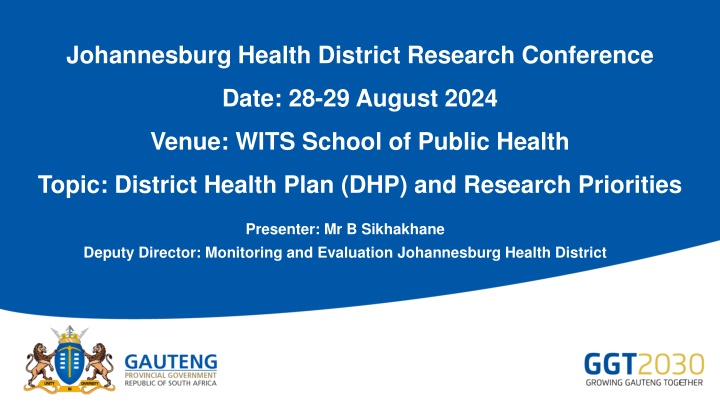
Johannesburg Health District Research Conference 2024 Overview
Explore the Johannesburg Health District Research Conference 2024 focusing on the District Health Plan (DHP), research priorities, population demographics, service delivery platform, and implications for health. Gain insights into the district's health landscape and key areas of focus for improving healthcare services.
Uploaded on | 1 Views
Download Presentation

Please find below an Image/Link to download the presentation.
The content on the website is provided AS IS for your information and personal use only. It may not be sold, licensed, or shared on other websites without obtaining consent from the author. If you encounter any issues during the download, it is possible that the publisher has removed the file from their server.
You are allowed to download the files provided on this website for personal or commercial use, subject to the condition that they are used lawfully. All files are the property of their respective owners.
The content on the website is provided AS IS for your information and personal use only. It may not be sold, licensed, or shared on other websites without obtaining consent from the author.
E N D
Presentation Transcript
Johannesburg Health District Research Conference Date: 28-29 August 2024 Venue: WITS School of Public Health Topic: District Health Plan (DHP) and Research Priorities Presenter: Mr B Sikhakhane Deputy Director: Monitoring and Evaluation Johannesburg Health District
Presentation Outline Johannesburg Health District Overview Demographics Service Delivery Platform District Health Plan (DHP) What is the DHP and where does fit in the Governmentwide Planning Framework? DHP Planning Process DHP Aspirations District Research Priorities
Johannesburg Population Pyramid - Implications for Health Young population - shows a bulge in the 20 to 39 age group Increased demand for maternal and child health services, family planning, and reproductive health education. Reproductive Health Young adults may be more susceptible to certain infectious diseases due to lifestyle factors may be more prone to engaging in risky behaviours such as substance abuse Infectious Diseases & Behavioural Health There may be greater emphasis on occupational health and safety measures Workforce Health & safety As individuals age within this demographic, there may be an increased prevalence of chronic diseases Chronic Disease Management Plan for increased healthcare infrastructure, including hospitals, clinics, and healthcare professionals, to meet the needs of a growing young adult population. Healthcare Infrastructure Planning Present opportunities for health education and promotion programs targeted towards young adults Health Education and Promotion Source: City of Johannesburg, 2023/24 IDP
Population Distribution Unit Total Population % of District % of Province Gauteng Province 16 723 636 - - City of Johannesburg Metropolitan 6 465 812 - 39% Municipality Johannesburg A Health sub-District 1 064 603 16% 6% Johannesburg B Health sub-District 348 630 5% 2% Johannesburg C Health sub-District 741 587 11% 4% Johannesburg D Health sub-District 1 615 422 25% 10% Johannesburg E Health sub-District 651 534 10% 4% Johannesburg F Health sub-District 1 077 845 17% 6% Johannesburg G Health sub-District 966 191 15% 6% Source: DHIS 2024
Service Delivery Platform Sub-District Type JHB A A B C D E F G Clinic 12 12 24 8 13 24 101 8 E CHC 2 1 1 5 1 1 13 2 C Mobile Service 5 2 4 5 1 3 6 26 B Satellite Clinic 0 1 0 0 0 1 - 2 D District Hospital 0 - 0 1 - 1 1 3 F Regional Hospital 0 1 0 0 1 - - 2 Provincial Tertiary Hospital 0 1 0 0 -- - 1 G National Central Hospital 0 0 0 1 - 1 - 2
Where does the DHP Fit in the Governmentwide Planning Framework? Long term plan Cut Across all sectors Critical steps towards 2030 National Development Plan (NDP) 2030 Five-year plan Sets out actions government will take to implement the NDP for a specific electoral term Medium Term Strategic Framework (MTSF) Medium Term Expenditure Framework (MTEF) Enables government institutions to do strategic planning Draws up annual budgets in rolling three-year cycles. Five-year sectoral & institutional plans Includes priorities in the MTSF Strategic plans are tools that enable departments to priorities and plan the incremental implementation of more long-term strategic intentions Sectoral & Institutional Plan Annual Performance Plan (APP) Actions required to meet sectoral and intuitional plans in a given financial year Strategic and operational document District Health Plan (DHP) Guides delivery of health services in a district Translates APP into district actions
DHP Planning Process Source: District Health Planning and Monitoring Framework, National Department of Health, August 2017
DHP Planning Process The Diagnosis Step Percentage of deaths by broad cause and leading causes, 2012 2017, JHB Metropolitan District Identify major problems - Communicable, maternal, perinatal, & nutritional conditions contribute significantly to <5 years deaths - HIV & TB deaths are higher in the 15-24 female cohort & 25-64 age group for both genders - Non communicable diseases are significant cause of deaths in the district with the 65+ deaths accounting for a largest proportion - Injury are notable higher in the 5-14 and 15-24 age groups for males Source: District Health Barometer 2019-20 Conduct a root-cause analysis and identify key interventions
DHP 2024/25-2026/27 Aspirations Aspiration Rationale An increased number of contacts between a pregnant woman Reduce from 98.7 to 85 maternal deaths per and a skilled health provider is most likely to reduce perinatal 100,000 live births by 2026/27 year mortality and improve women s experience of care. Reduce from 14 to 10 neonatal deaths per 1000 Includes women s health focussing on sexual and live births by 2026/27 reproductive health To reduce preventable deaths among children under five years through prevention and improved management of Reduce from 1,8 to 1.4 of children under 5 common childhood illnesses. years who die in health facilities rate by 2040/25 Neonatal deaths are the major contributor to deaths under- year fives in the district and therefore paying special attention to reduction of neonatal deaths will significantly reduce under- fives deaths
DHP 2024/25-2026/27 Aspirations Aspiration Rationale Viral load suppression is not only a reliable and non- patient-based measure of adherence, but it also helps to Increase people living with HIV and AIDS with keep PLHIV healthy and prevents illness. suppressed viral loads to 95% by 2026/27 year It is against this logic that the district will test for HIV, through testing, initiation, and retention on treatment initiate, and retain clients on treatment to keep them healthy and monitor adherence (viral load suppression) Increase TB treatment success rate to 95% by TB is both preventable and curable and yet it remains 2026/27 through case identification and diagnosis, one of the leading causes of deaths in the district. By treatment initiation and completion (cured and scaling up TB treatment outcomes through better case completed treatment) identification and management, the district will reduce deaths due to this scourge Increase MDR-TB treatment success rate to 90%
DHP 2024/25-2026/27 Aspiration Aspiration Rationale To rapidly diagnose and better treat malaria through an active Reduce deaths due malaria < 1% by surveillance system continue to curtail deaths due to malaria and 2026/27 year prevent further spread. Untreated/uncontrolled diabetes can lead to complications such as Men and Women 18 years and older heart disease, stroke, kidney damage and nerve damage. with diabetes managed (identification To prevent and manage the condition and prevent associated and treatment) complications Untreated/uncontrolled, hypertension is the single largest contributor Men and Women 18 years and older to cardiovascular disease, causing stroke, heart failure, and coronary with hypertension managed artery disease, and is a major contributor to kidney disease. (identification and treatment) To prevent and if already diagnosed to manage the conditions and prevent associated complications
DHP 2024/25-2026/27 Aspiration Rationale School Grade 1 learners screened Is not only to identify avoidable health problems that may constitute barriers to learning, but also as an opportunity of healthy development in School Grade 8 learners screened children Increase % of PHC facilities that qualify as Ideal clinics from 75% to 95% by 2026/27 Increasing the number of PHC qualifying as ideal Increase % of patients satisfied with their experience of clinics infers that infrastructural, safety issues, care in public health facilities from 75% to 95% by 2026/27 availability of medication and other supplies are Increase % of health facilities compliant with Occupational implemented to comply with the ideal clinic Health and Safety Standards to 100% by 2026/27 standards and thus improving quality of health Health facilities refurbished and adequately maintained to ensure effective service delivery
DHP 2024/25-2026/27 Aspirations Aspiration Rationale Is to make collecting chronic medication more accessible as stable patients pick their medication at points nearest/convenient to them away from health facilities and therefore decrease waiting times and over-crowding in health facilities Integrating mental health care into primary care and all other levels of care to ensure that mental health is accessible, affordable, and acceptable to people with mental health problems Not only access to health care service is important but access to the type of health care when needed is also important Increase number of patients enrolled on centralized chronic medicine dispensing and distribution programme (CCMDD) Quality mental health and rehabilitation services integrated into PHC health care facilities, Improve access to health services increasing the number CHC operating 24 hours Organizational performance management and accountability is supported by availability of timely, accurate and usable information extracted from quality data Support Automation for data collection, flow, storage, and visualisation for effective performance information management
DHP 2024/25-2026/27 Aspirations Aspiration Rationale Quality healthcare depends on the availability of talented, Improve equity, training and enhance management capable, motivated, and high-performing clinical and non- of Human Resources for Health in the district clinical staff. Managing limited financial resources will enhance economical and efficient delivery of outputs required to Improve Financial Management achieve desired outcomes (effectiveness), that will serve the needs of the community
District Research Priorities National Health Research Strategy: Research Priorities for South Africa 2021-2024 The NHRC in identifying health research priorities, took into consideration the followings: the burden of disease. the cost-effectiveness of interventions aimed at reducing the burden of disease. the availability of human and institutional resources for the implementation of an intervention at the level closest to the affected communities. the health needs of vulnerable groups such as woman, older persons, children people with disabilities; and the health needs of communities
District Research Priorities Stream Priority Objective Rationale The shift towards urban Study the prevalence of lifestyles has led to an increase Lifestyle-Related lifestyle-related NCDs, in NCDs, which are now NCDs particularly diabetes, and among the leading causes of hypertension mortality in Johannesburg Non- Communicable Explore mental health The fast-paced, high-stress Diseases (NCDs) challenges associated with urban environment in Mental Health in urban living, such as stress, Johannesburg contributes to a Urban Settings anxiety, and depression, and growing mental health crisis, evaluate existing support requiring targeted research systems. and interventions
District Research Priorities Stream Priority Objective Rationale Research the co-infection rates of HIV and TB in JHB & the effectiveness of integrated treatment programs HIV/AIDS and TB Co- Infection HIV and TB co-infection remains a significant public health issue Study factors influencing loss to follow-up Explore the effectiveness of differentiated care models, such as multi-month ART dispensing, to improve adherence and retention. Ensure sustained engagement in HIV care to prevent progression to advanced disease. Communicable Diseases Managing advanced HIV disease Reduce morbidity and mortality from opportunistic infections and other comorbidities in people with advanced HIV. Research the prevalence and risk factors for common opportunistic infections in advanced HIV patients..
District Research Priorities Stream Priority Objective Rationale Infectious JHB faces risk of and experiences Study the city s preparedness and Disease infectious disease outbreaks, Communicable response to infectious disease Outbreak necessitating research into Diseases outbreaks Preparedness prevention and response strategies. Substance abuse is a significant Study the prevalence of alcohol public health issue in JHB and drug abuse in Johannesburg contributing to both health and and its impact on public health Substance social problems Alcohol and Drug Abuse and Abuse Evaluate effectiveness of current Improving access to & the Public Health substance abuse treatment & effectiveness of substance abuse rehabilitation programs and treatment is critical for addressing explore strategies for improvement this pervasive issue
District Research Priorities Stream Priority Objective Rationale Research the impact of air pollution on respiratory Johannesburg s high levels of air Air Quality and diseases, particularly asthma pollution from traffic and industry Respiratory and chronic obstructive contribute to a significant burden pulmonary disease (COPD), in of respiratory illnesses Urban Health and urban areas. Environmental Factors Access to clean water and Investigate quality of drinking proper sanitation is critical for Water and water and sanitation in informal preventing waterborne diseases, Sanitation settlements and their impact on which are prevalent in densely public health. populated areas.
District Research Priorities Stream Priority Objective Rationale Research the leading causes Reducing Infant Despite improvements, maternal of infant and maternal mortality Maternal and and Maternal and infant mortality rates remain in Johannesburg and develop Child Health Mortality concerning in certain areas targeted interventions
Gap Availability data at local level Conducting health research at the municipal ward level: allows for highly localized data collection and analysis. Can provide insights into the specific: health needs, challenges, and resources of smaller communities within a municipality. This approach can lead to: better understanding of health disparities within a municipality support targeted interventions that are responsive to the specific needs of each ward. Johannesburg Metropolitan Municipality has 131 municipal wards



















